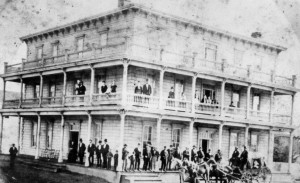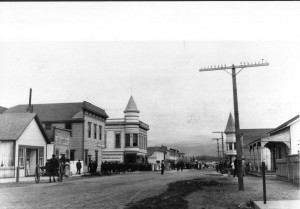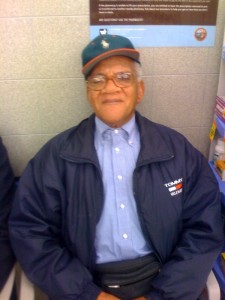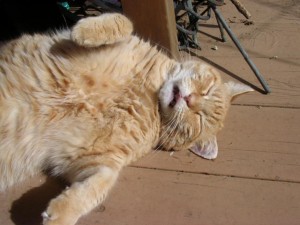
Nature Watch: Message from Barbara Mauz
Story by Barbara Mauz (Nature Watch)
Email Barbara ([email protected]
Take a look at the pair of excellent letters below — it is important that the Board of Supervisors hear from you regarding their proposal to take away your opportunity to have people represent you LOCALLY, on the Mid-Coast Community Council, instead of “over the hill” in Redwood City.
When you have locally elected representatives, and in this case, all of the Mid-Coast Community Council members are folks who actually live on the Coastside—that means locals have easy access to the members of the council because they are our neighbors and know better than anyone the problems that the unique Coastside faces.
Please take a couple of minutes after reading these two letters to send a message to them to (1) Appoint Ric Lohman to represent you on the Mid-Coast Community Council – Ric has a very good knowledge & understanding of the Mid-Coast and with his previous experience on the Mid-Coast Community Council will be able to guide that group towards making decisions that will be beneficial to the Mid-Coast’s Tax-Paying Homeowners and, (2) Oppose Supervisor Richard Gordon’s Resolution to restrict the membership of the Midcoast Community Council. Note that the first letter contains the E-mail address’ of each Supervisor. You can send your E-mail letter to all of them by putting each of their E-maill address’ in the “To” line any time before that item comes up on their agenda at 10:15 a.m. tomorrow – 1/17/09. In the Subject line indicate “Item 12 – 10:15 a.m. – Open Seat on Midcoast Community Council & Resolution”.
Just click on the “Supporting Document” below to read the Board Memo. You may also want to read letter/comments about this posted at http://www.coastsider.com /Thanks, Barb Mauz Continue reading “Nature Watch: Message from Barbara Mauz”
1890s: Crystal Springs Lake: No Swimming Allowed Here
In the summer of 1890, it was a common sight to see boating parties skimming along Crystal Springs Lake. The rowboats and sailboats, reserved for the exclusive use of Spring Valley Water Co. employees, were always moored there. It was even possible to glimpse a company worker bathing in the lake, the source of drinking water for San Francisco and Peninsula suburbs.
The 11 miles of beautiful manmade lakes were brilliantly engineered over a 30-year period by the water company. Quietly it acquired farms and bought and razed an old resort hotel, partially submerging the tiny communities of Laguna and Crystal Springs. By 1890 the water company dominated the area.
That August, what began as a Sunday afternoon pleasure ride on Upper Crystal Springs Lake, orchestrated by a Spring Valley Water Co. superintendent, abruptly turned to tragedy.
Earlier that day, friends gathered for lunch at the lakeside residence of Mr. and Mrs. Albert P. Lawrence. He was the 36-year-old so-called “keeper of the Crystal Springs Upper Reservoir”– divided from the lower lakes by the Old Crystal Springs dam, now a causeway between the lakes. Lawrence, a nephew of a county supervisor, was well-liked.
Among those present at the Lawrence luncheon was 20-year-old Nellie McNamara and members of her family, including her mother, who still resided in what remained of the Laguna community.
Albert Lawrence, father of 8-year-old Ray, acted as a trustee of the Laguna School District. A college graduate, he taught school on the East Coast before moving to San Mateo County.
Arriving by stage for the Sunday festivities was Spring Valley Water Co. carpenter Sylvester Quinn, a 27-year-old bachelor and a widely known character whose father and brothers “lived on the mountain.” Others came from nearby and everyone was known except 21-year-old Lizzie Garl, a visitor from San Francisco who was staying with her godfather in Laguna.
The luncheon party recognized the Spring Valley Water Co.’s continuing unpopularity and its reputation as a callused monopoly. They discussed recent rumors, including the latest that at least one employee allegedly bathed in the lake regularly. When his clothes were found on the shore, there were charges that the employee had never emerged and his body was decomposing at the bottom of the lake. Critics of the water company seized on the story as a shocking example of the lack of concern for the purity of the drinking water.
The day of the luncheon was inviting and the guests enjoyed wandering through the grounds surrounding the lake. With the meal over, Albert P. Lawrence suggested a leisurely sail on the lake in the company-owned green Whitehall sailboat.
Glancing out of the window, and observing the wind rippling the water’s surface, Lawrence’s wife declined the invitation. Instead, she persuaded another female guest to join her in a rowboat.
Lizzie Garl and Nellie McNamara showed no concern or fear about accompanying Albert Lawrence and Sylvester Quinn in the sailboat. While the men were expert swimmers, no one knew how well the two young women could swim.
Two rowboats, holding nine guests, with Mrs. Lawrence in the first and Nellie McNamara’s twin sister, Annie, and mother in the second, followed the Lawrence sailboat south toward Woodside. A man on horseback and a blacksmith observed Lawrence, Quinn and the two women in the sailboat skirting the shores.
With the sailboat in the lead, the three boats headed north about 3 p.m. Nearing the boathouse and within 100 feet of shore where the water measured 15 feet deep, Albert Lawrence tacked. In coming about quickly, the line attached to the boom became entangled–and as the boat swung around, a squall struck it broadside.
The sailboat capsized, throwing its occupants and tangled rigging in the water.
Mrs. Lawrence, in the first boat, stood up and screamed as she witnessed the struggle in the water. Lizzie Garl and Sylvester Quinn sank and drowned immediately. On the banks, her young son, Ray, shouted to his father. The young boy’s impulse was to help, but a family friend restrained him.
Witnesses’ accounts varied on what happened next. Albert, who could have saved himself, tried to help Nellie. According to the San Mateo Times & Gazette, he nearly placed her safely on the keel of the boat three times, but her foot was trapped in the ropes, and she kept slipping back into the water.
The occupants of the two rowboats gathered on shore. Two young men pulled off their coats, dived into the lake and swan toward the overturned boat–but they were too late.
By then, both Nellie and Albert were weak and exhausted. Nellie made one final effort, clinging to Albert. He could not help her nor was he able to free himself from her embrace. While those on shore watched in horror, the pair slipped beneath the surface of Upper Crystal Springs Lake.
News of the four drownings was telegraphed to San Mateo, with a special request that Albert’s uncle, Supervisor W.B. Lawrence, come to the lake at once.
When the supervisor arrived, George Schussler directed employees to drag three grappling hooks along the lake bottom. George was the brother of Hermann Schussler, the German engineer of the water company’s new Crystal Springs cement dam, publicized as the world’s largest.
By 6 p.m., news of the tragedy reached the surrounding countryside, shocking residents and bringing crowds of volunteers and the curious to Upper Crystal Springs Lake.
When the green sailboat was finally turned upright, startled rescuers found Nellie’s body caught in the rigging. Her body was taken to her father’s home in Laguna.
As night fell, hundreds of lanterns were lit, illuminating the dark lakeside and the newly completed dam. Volunteers in four boats plied the lake with one man kneeling in each boat holding a rope attached to a grappling iron and a heavy weight. The men checked each obstruction that the hooks snagged.
It was 11 p.m. when Lizzie Garl’s body was recovered.
Two and a half hours later, a call for help floated across the lake. A grappling iron rose slowly in the surface revealing first a shoe, then the body of Sylvester Quinn. The popular carpenter was well known in Half Moon Bay, San Mateo and San Francisco; his brothers carried his body to their father’s home “on the mountain.”
By the time Albert Lawrence’s body was recovered at 2 a.m., his wife was so grief-stricken she refused to leave his side.
Albert “was one of those kind of men who have that charity which both gives and forgives,” said a family spokesperson. “He was the same every day and the same to every person.”
A coroner’s jury was summoned Sunday evening and an inquest was held Monday morning.
“A few minutes before the accident, I rode around a bend in the road leading to the dam and noticed a Whitehall boat sailing down the lake,” testified J.J. Casey, the first witness.
“When about half the length of the lake,” Casey continued, “the boat turned and came back. Another bend in the road prevented further view of the boat until a few moments later, when I saw the four struggling victims with the upturned boat in the midst of them.”
H. Eng said he “was at work in a blacksmith shop which is located below the embankment on the opposite side of the lake. An alarm was given by several workmen shouting and running about wildly.
“At first I paid no attention, but afterward became convinced that some accident had happened and hastened to the scene,” Eng said. “I took off my apron and was about to jump in when someone stopped me. I then ran for a boat some distance away on the bank, but just as I reached the struggling victims they went down.
After hearing more statements, the coroner’s jury returned a verdict of accidental death in the drownings.
Lizzie Garl was interred in San Francisco; Nellie McNamara and Sylvester Quinn in San Mateo.
Albert’s funeral was the largest, with 84 carriages bearing Masonic Lodge members, relatives and friends slowly following the hearse to St. John’s historic cemetery in San Mateo. Pallbearers represented different parts of the county, and included Half Moon Bay’s Ferdinand Levy, J.W. McLean of San Mateo and Redwood City’s George Holder and G.P. Hartley.
Stunned by the four young people’s drownings, the tragic accident led to a campaign to initiate stringent regulations prohibiting the use of reservoirs for pleasure purposes.
“This should be done to ensure cleanliness to the consumers of the water and as a means of prohibiting venturesome and reckless pleasure-seekers from exposing themselves to unnecessary dangers,” wrote the editor of the Coastside Advocate. “If the managers of this opulent water corporation have not sufficient consideration for their customers to offer what protection against cleanliness is in their power, then it is the moral duty of the county officials to take the matter in hand, and see if it is not possible to exclude bathers and boating parties from this dangerous body of water.”
The demand for eliminating pleasure boating in Crystal Springs reservoir was taken seriously. Today, no such excursions take place, and no one questions the purity of the water.
=========
“A not-new story” by June Morrall
Long Ago Main Street

Pioneer Banker/ Bank of America founder A.P. Giannini is Jumping Out of His Grave
A.P. Giannini’s Four Rules of Success
* Pick a business you love.
* Save $1000 and invest it in that same business.
* Own your own home.
* Know what you want to be doing a year from today.
Mr. Giannini’s formula drew nationwide attention when it was published in Coronet magazine in 1945, four years before his death.
When A.P. Giannini died in the summer of 1949, San Mateo residents were”irked” by press reports that mistakenly identified the world famous banker’s home address as Hillsborough.
On the surface, the misinformation appeared insignificant, a minor
error, but it was no small matter to many Peninsulans who took pride that the legendary “people’s banker” had resided on El Cerrito Avenue in San Mateo for decades.
Some locals were sufficiently miffed to interrupt their summer vacations in order to fire-off telegrams to this very newspaper. The San Mateo Times responded by quietly alerting United Press, and the dateline on A.P. Giannini’s obituary was quickly changed from Hillsborough to San Mateo.
It was an honest mistake. “Seven Oaks”, the ten-room English
Tudor-style house owned by the founder of the Bank of Italy, forerunner to the Bank of America, stood within steps of the Hillsborough community. El Cerrito Avenue was a borderline street, with one-third belonging to Hillsborough, and the other two-thirds located in the city of San Mateo. Giannini’s gabled house, unpretentious, surrounded by an acre of garden, was unquestionably located in San Mateo.
Although the 6’2″ A.P. Giannini cut an impressive figure, he did not match the portrait of the traditional banker. He was the son of Italian immigrants whose experience was limited to his success in the produce business.
Perhaps it was fitting that A.P. didn’t have that exclusive Hillsborough address. For in that lofty community the stuffy wasp bankers were disdainful of the produce man who set out to modernize their way of doing business.
They learned that A.P. was a pioneer who would revolutionize the banking industry. Giannini believed in the average man, reaching out to him as a customer, and while the staid bankers were looking down their noses at Giannini, A.P. was building the world’s largest bank. Continue reading “Pioneer Banker/ Bank of America founder A.P. Giannini is Jumping Out of His Grave”
Walter Ruhlmann: “May the last day of 2008 be sweet to you”
Although we have already tip-toed into 2009, poetry editor Walter Ruhlmann’s message remains warm.
——-
 Hello Dear Ones
Hello Dear Ones
I am proud to announce that you can now find the first three issues of mgv2>datura published on line at issuu.com
The issues are still on mgv2 website but as they appear on issuu.
From now on, all new issues will be published that way, which offers your work a smarter canva
May the last day of 2008 be sweet to you.
I’ll get back to you next year.
Best
Walter Ruhlmann – editor
http://mgversion2.free.fr
[email protected]
———————–
Hello June,
…There should be a new issue some time soon. I even wonder if I’m not going to drop the French side of the lit mag to develop only the English one. English speaking writers are sometimes more interesting than French ones, who are always a bit selfish and unfair, never expressing much gratitude…
Walter
I met Leon Wilson “the legend of Half Moon Bay”
At the Rite Aid Pharmacy in town, I met the most charming man: Leon Wilson. I was delighted to learn that he is “the legend of Half Moon Bay,” having worked for building contractors for four decades.

Mark Litke: Focussing his mind’s lens on the world
After forwarding an email to Lincoln High School classmate Mark Litke, the former ABC newsman (stationed in Hong Kong) told me what’s new in his professional life:
 Mark Litke: I’ve recently hooked up with a new PBS program (World Focus)…a newscast dedicated to international news coverage. They have aired six of my stories, including a four-part series on Vietnam that aired last week. They have been very well received. And judging by the viewer comments, they broadcast is reaching a number of thoughtful people in search of more meaningful news reporting on television. Check out the website: worldfocus.org You can watch the entire show on line…or pull up any individual story from the archive.
Mark Litke: I’ve recently hooked up with a new PBS program (World Focus)…a newscast dedicated to international news coverage. They have aired six of my stories, including a four-part series on Vietnam that aired last week. They have been very well received. And judging by the viewer comments, they broadcast is reaching a number of thoughtful people in search of more meaningful news reporting on television. Check out the website: worldfocus.org You can watch the entire show on line…or pull up any individual story from the archive.
Meet “Sweet Pea,” aka “Bubba, the love-ah”
Yep, from the pound. Thanks Katie.

“Got a little Captain in you?”
 The Captain Morgan Rum commercials have been all over tv, so it’s likely you’ve seen one of the off-beat “Got a little Captain in you?” ads.
The Captain Morgan Rum commercials have been all over tv, so it’s likely you’ve seen one of the off-beat “Got a little Captain in you?” ads.
The “Got a little Captain in you?” refers to people after they drink the rum. They drink Captain Morgan because it’s different as they are. And, we learn from the commercial that Captain Morgan Rum IS very different, because, well, when you take a sip while standing up, ONE of your legs may suddenly rise and bend at the knee, signaling that you’ve got a little of “Captain” in you.
When you see a row of people with a “little Captain” in them, it’s quite effective. And from the beginning, I wondered if there was any basis in fact to having a “little “Captain” in anyone.
I found the answer in the book, Discovery of France ,by Graham Robb, in the unnumbered picture section, between pages 142-43. The caption describes the 1905 photo as a staged scene in the spa town of La Bourboule. The image shows country folk performing a dance called the bourree—and it certainly looks like they have a “little Captain” in them.
